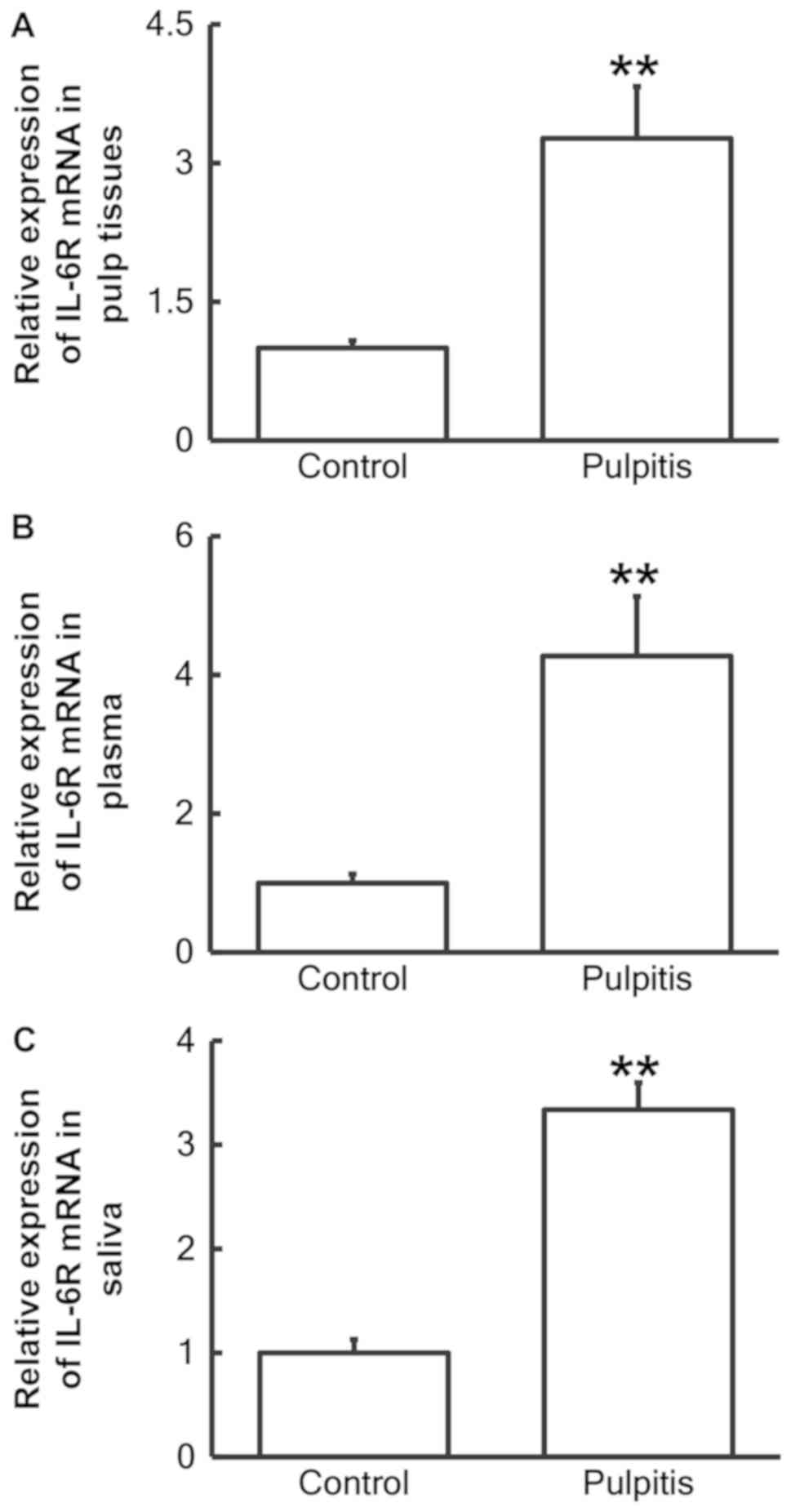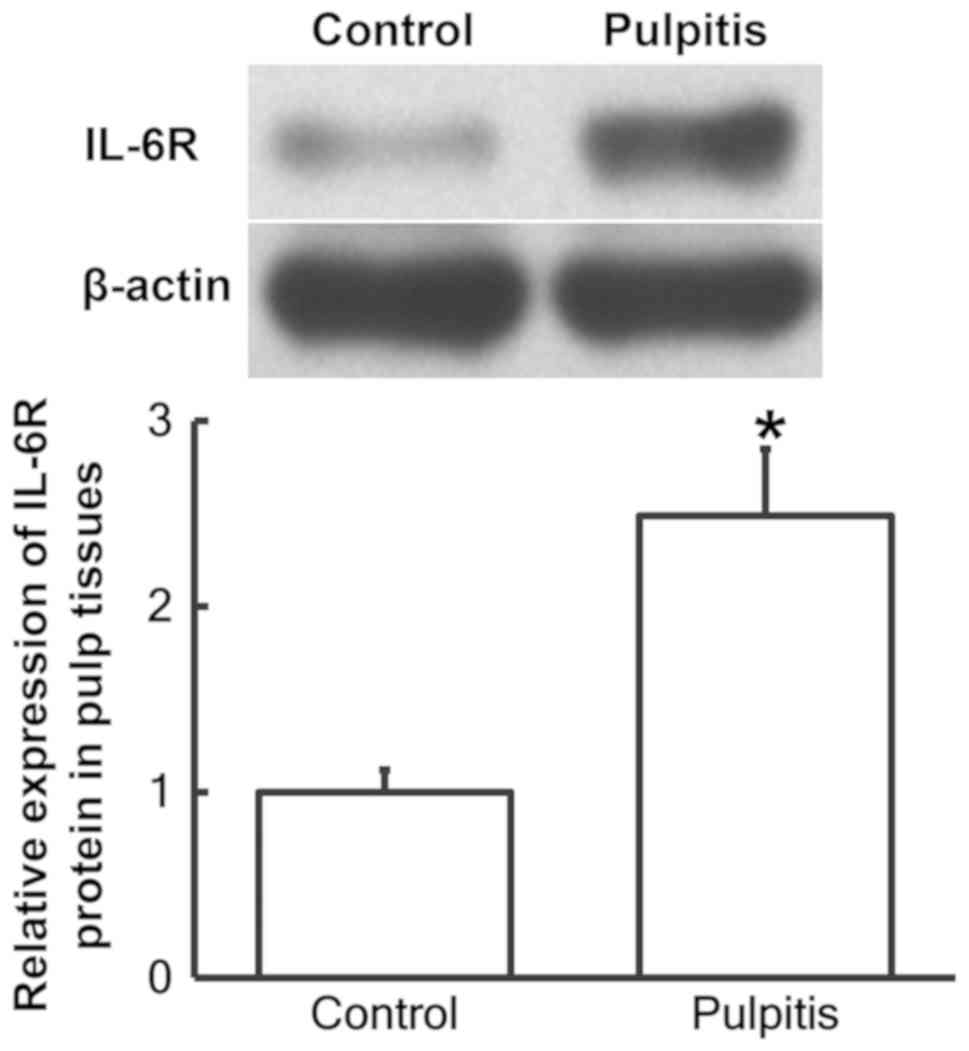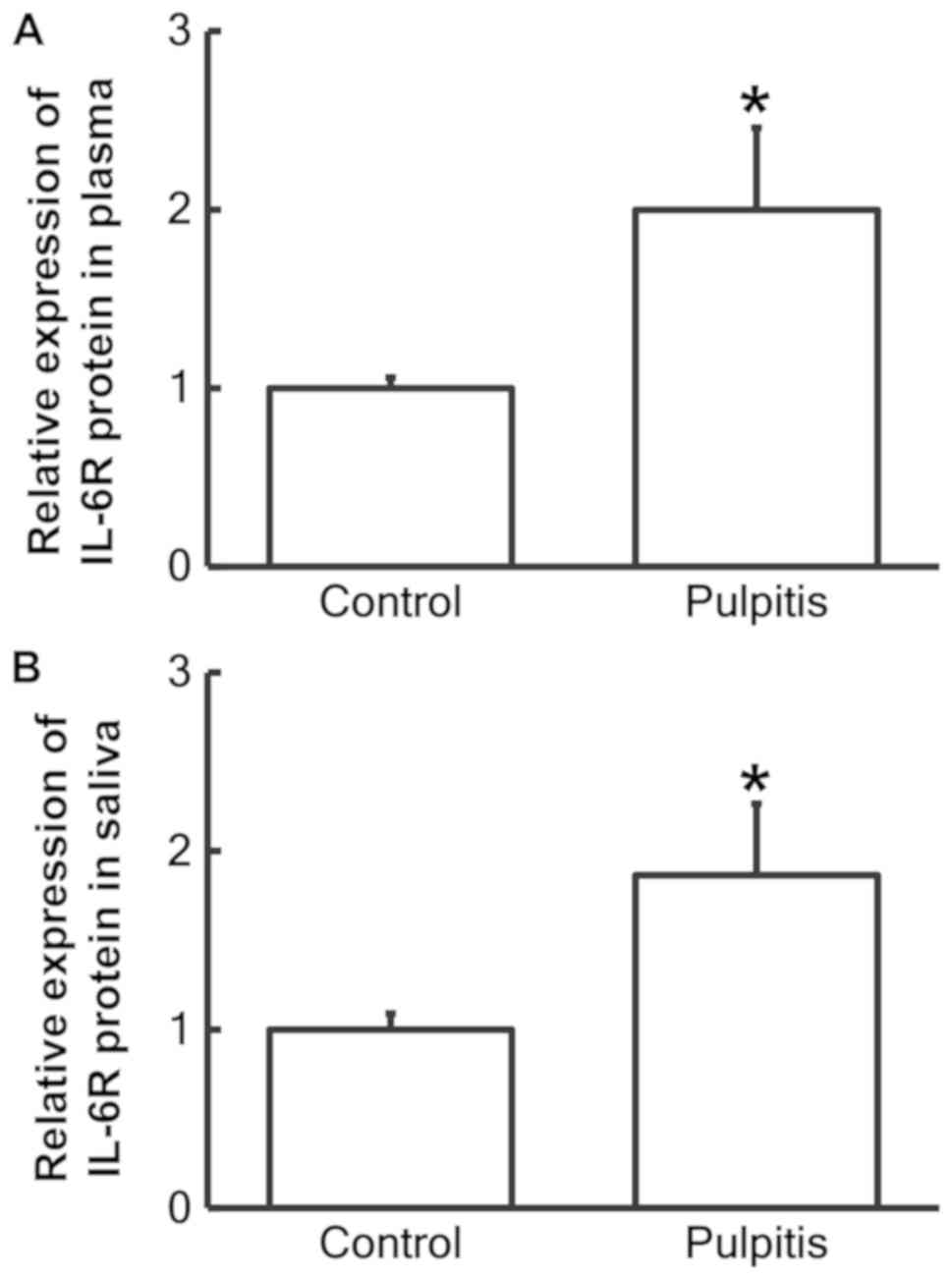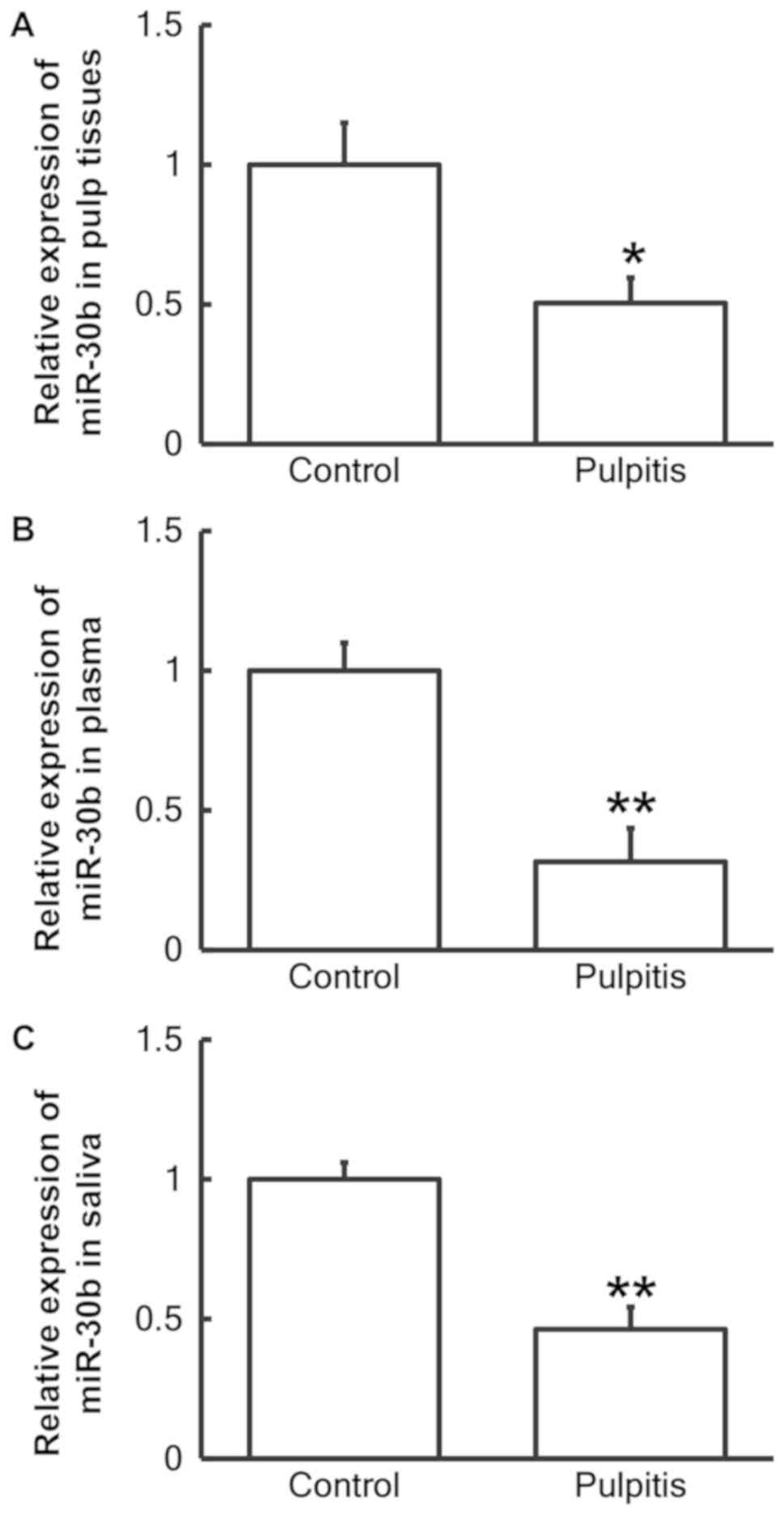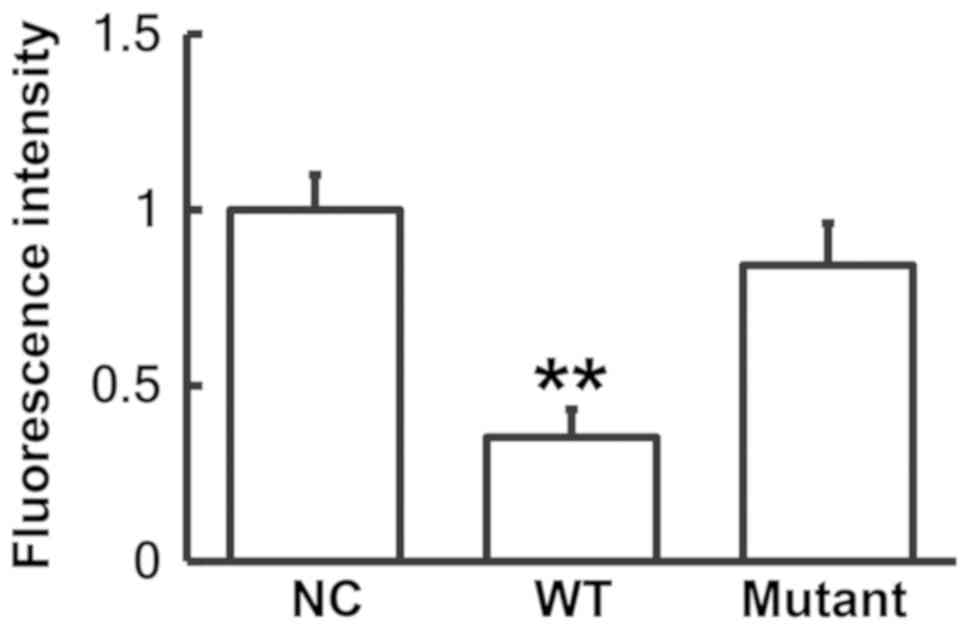Decreased expression of microRNA‑30b promotes the development of pulpitis by upregulating the expression of interleukin‑6 receptor
- Authors:
- Published online on: February 15, 2019 https://doi.org/10.3892/etm.2019.7280
- Pages: 3233-3238
Abstract
Introduction
Pulpitis is an inflammation of the dental pulp and the most common type of pathological disease to affect the pulp tissue; it is characterized by pain, which can be severe (1). The diagnosis and treatment of pulpitis are difficult as there are multiple causes, which can involve various different microbes. Therefore, pulpitis has become a focus in clinical research. Multiple factors are responsible for the occurrence of pulpitis, including bacterial infection, physical and chemical stimulation and the immune response, although bacterial infection is the primary cause (2,3). Obligate anaerobes and facultative anaerobes are the primary pathogens that cause pulpitis (4). Following lysis, Gram-negative bacteria release bacterial endotoxin, which has strong cytotoxicity and antigenicity (5). Endotoxin may directly destroy the local tissues and induce an inflammatory reaction (6). It has been previously reported that endotoxin induces the release of prostaglandins, interleukin (IL), leukotrienes, transforming growth factor and tumor necrosis factor (TNF) by macrophages and pulp cells (7). IL-6 is a key cytokine in inflammatory processes and has been previously reported to serve an important role in the pathogenesis of pulpitis (8,9). However, IL-6 only exerts its biological effects after binding with the IL-6 receptor (IL-6R) to form an IL-6/IL-6R complex, which is subsequently combined with gp130 to form a high-affinity complex (10). However, the regulatory effects of IL-6R in pulpitis and the regulatory mechanism of the upstream genes of IL-6R have not been entirely identified.
MicroRNAs (miRNAs or miRs) are a type of non-coding, small RNA molecule made up of 18–22 nucleotides, which regulate the expression of proteins at mRNA level in eukaryotes (11–13). The pathogenesis of pulpitis is accompanied by changes in the expression of a variety of miRNA molecules and proteins, suggesting that miRNA may serve important roles in the regulation of proteins associated with the disease (14–16). In the present study, the expression of IL-6R mRNA and protein were examined in pulp tissues, blood and saliva from patients with pulpitis. The association between IL-6R and miR-30b was also investigated as well as their effects on pulpitis.
Patients and methods
Patients
A total of 28 patients with pulpitis (12 male and 16 female; age range, 20–51 years; median age, 37.6 years) who underwent tooth extraction at Nanjing Stomatological Hospital (Nanjing, China) and The First Affiliated Hospital of Nanjing Medical University (Nanjing, China) between June 2014 and December 2016 were recruited into the experimental group. A total of 16 subjects who had no pulpitis but also underwent a tooth extraction operation (6 male and 10 female; age range, 19–52 years; median age, 36.9 years) were recruited into the control group. The exclusion criteria were: Intake of non-steroidal drugs, use of antibiotics and drinking alcohol or smoking within two weeks prior to diagnosis. Pulp tissues were collected from all subjects under sterile conditions, washed with saline and stored in liquid nitrogen (−196°C) prior to use. Fasting peripheral blood was collected from all subjects on the morning of the tooth extraction and plasma was separated from venous blood (30 ml) by centrifugation at 1,000 × g at 4°C for 10 min. Saliva was collected from all subjects prior to the operation on the day of tooth extraction and stored under −80°C prior to its further investigation. All procedures were approved by the Ethics Committee of Nanjing University (Nanjing, China) and written informed consent was obtained from all patients or their families prior to their inclusion within the study.
Reverse transcription-quantitative polymerase chain reaction (RT-qPCR)
Pulp tissues (100 mg) were ground into a powder in liquid nitrogen and lysed using 1 ml TRIzol reagent (Thermo Fisher Scientific, Waltham, MA, USA) according to the manufacturer's protocol. Plasma (100 µl) or saliva (100 µl) were directly lysed using 1 ml TRIzol reagent. Total RNA was extracted using the phenol chloroform method (17). RNA (1 µg) was reverse-transcribed into cDNA at 42°C for 60 min and stored at −20°C prior to further experimentation. The TIANScript II cDNA First Strand Synthesis Kit (Tiangen Biotech Co., Ltd., Beijing, China) was used for RT of mRNA and the miRcute miRNA First-strand cDNA Synthesis kit (Tiangen Biotech Co., Ltd.) was used for the reverse transcription of miRNA.
To detect IL-6R mRNA expression the SuperReal PreMix (SYBR-Green) RT-qPCR kit (Tiangen Biotech Co., Ltd.) was used and GAPDH was used as the internal reference gene. The primer sequences of IL-6R were forward, 5′-TGGTGGATGTTCCCCCCGAG-3′ and reverse, 5′-TCCTGGGAATACTGGCACGG-3′. The sequences of GAPDH were forward, 5′-AAGGCTGTGGGCAAGG-3′ and reverse, 5′-TGGAGGAGTGGGTGTCG-3′. The reaction system (20 µl) was composed of RT-qPCR-Mix (10 µl), upstream primer (0.5 µl), downstream primer (0.5 µl), cDNA (2 µl) and ddH2O (7 µl). The PCR protocol was as follows: Initial denaturation at 95°C for 30 sec; denaturation at 95°C for 5 sec and 39 cycles for elongation at 60°C for 20 sec (iQ5; Bio-Rad Laboratories, Inc., Hercules, CA, USA). The 2−ΔΔCq method (18) was used to calculate the relative expression of IL-6R mRNA against GAPDH. Each sample was examined in triplicate.
The miRcute miRNA RT-PCR kit (Tiangen Biotech Co., Ltd.) was used to detect the expression of miR-30b and U6 was used as the internal reference. The sequences of the miR-30b primers were forward, 5′-CGCGCTGTAAACATCCTACAC-3′ and reverse, 5′-GTGCAGGGTCCGAGGT-3′. The sequences of the U6 primers were forward, 5′-GCTTCGGCAGCACATATACTAAAAT-3′ and reverse, 5′-CGCTTCACGAATTTGCGTGTCAT-3′. The reaction system (20 µl) was the same as above. The reaction protocol was as follows: Initial denaturation at 95°C for 5 min; 95°C for 10 sec and 40 cycles at 60°C for 20 sec; and elongation at 72°C for 10 sec. The 2−ΔΔCq method was used to calculate the relative expression of miR-30b against U6. Each sample was tested in triplicate.
Western blot analysis
Tissue samples in each group were lysed with 600 µl precooled radioimmunoprecipitation assay lysis buffer (Beyotime Institute of Biotechnology, Haimen, China). Following lysis for 30 min on ice, the mixture was centrifuged at 1,200 × g for 10 min at 4°C. Protein concentration was determined from the supernatant using a bicinchoninic acid determination kit (cat. no. RTP7102; Real-Times Biotechnology Co., Ltd., Beijing, China). The protein samples were subsequently mixed with 5X SDS loading buffer. Following denaturation in boiling water for 5 min, the 20 µg samples were loaded onto 10% SDS-PAGE for electrophoresis. The resolved proteins were transferred to polyvinylidene difluoride membranes on ice (100 V for 2 h) and blocked with 5% skimmed milk at room temperature for 1 h. The membranes were incubated with rabbit anti-human IL-6R (1:1,000; cat. no. ab128008) and β-actin (1:5,000; cat. no. ab8227) polyclonal primary antibodies (Abcam, Cambridge, UK) at 4°C overnight. Following washing 5 times (5 min each time) with PBS with Tween-20 (PBST), the membranes were incubated with goat anti-rabbit horseradish peroxidase (HRP)-conjugated secondary antibodies (1:3,000; cat. no. ab6721; Abcam) for 1 h at room temperature prior to washing again with PBST 5 times (5 min each time). The membranes were subsequently developed using an enhanced chemiluminescence detection kit (cat. no. 11520709001; Sigma-Aldrich; Merck KGaA, Darmstadt, Germany) for imaging. Image Lab v3.0 software (Bio-Rad Laboratories, Inc.) was used to acquire and analyze the imaging signals. The relative content of IL-6R protein was expressed against β-actin.
ELISA
An IL-6R ELISA kit (Shanghai Joe Feather Biological Science and Technology Co., Ltd., Shanghai, China) was used to determine the concentration of IL-6R in plasma and saliva samples. In 96-well microplates, the standards (50 µl) and samples (10 µl liquid samples and 40 µl diluent) were added into the predefined wells, while the blank wells were left empty. In the wells for standards and samples, HRP-labeled conjugates (100 µl) were added prior to sealing the plates for incubation at 37°C for 1 h. Following washing of the plates 5 times, the substrates A (50 µl) and B (50 µl) were added into each well. After incubation at 37°C for 15 min, the stop solution (50 µl) was added into each well and the absorbance of each well was measured at 450 nm within 15 min.
Dual luciferase reporter assay
Bioinformatics prediction is a powerful tool used to study the various functions of miRNAs. To understand the regulatory mechanism of IL-6R miRanda (microrna.org/microrna/home.do), TargetScan (targetscan.org), PiTa (genie.weizmann.ac.il/pubs/mir07/mir07_data.html), RNAhybrid (bibiserv.techfak.uni-bielefeld.de/rnahybrid/) and PICTA (pictar.mdc-berlin.de/) were used to predict the miRNA molecules that may regulate IL-6R. The databases revealed that miR-30b may potentially regulate IL-6R.
Based on the bioinformatics results, wild-type (WT) and mutant seed regions of miR-30b in the 3′-untranslated region (UTR) of the IL-6R gene were chemically synthesized in vitro by Sangon Biotech Co., Ltd., Shanghai, China). The two ends were subsequently attached using the Spe1 and HindIII restriction sites and cloned into pMIR-REPORT luciferase reporter plasmids (Ambion) using Lipofectamine 2000 (both Thermo Fisher Scientific, Inc.). Plasmids (0.8 µg) with either the negative control (NC), WT or mutant 3′-UTR DNA sequences were co-transfected with agomiR-30b (100 nM; Sangon Biotech Co., Ltd.) into 293T cells. Following incubation at 37°C for 24 h, the cells were lysed using a dual luciferase reporter assay kit (Promega Corporation, Fitchburg, WI, USA) according to the manufacturer's manual. Fluorescence intensity was measured using a GloMax 20/20 luminometer (Promega Corporation). The fluorescence values of each group of cells were measured using Renilla fluorescence activity as the internal reference.
Statistical analysis
The results were analyzed using SPSS 18.0 statistical software (SPSS, Inc., Chicago, IL, USA). The data were expressed as the mean ± standard deviation. The data were tested for normality and multi-group data were analyzed using one-way analysis of variance. In cases of homogeneity of variance the Least Significant Difference and Student-Newman-Keuls post hoc methods were used; in cases of heterogeneity of variance the Tamhane's T2 or Dunnett's T3 post hoc methods were used. Comparison between two groups was performed using a Student's t-test. Each test was repeated at least 3 times. P<0.05 was considered to indicate a statistically significant difference.
Results
Expression of IL-6R mRNA is significantly elevated in pulp tissues, plasma and saliva from patients with pulpitis
RT-qPCR was performed to measure the expression of IL-6R mRNA in pulp tissue, plasma and saliva. The data revealed that the IL-6R mRNA levels in the pulp tissue (Fig. 1A), plasma (Fig. 1B) and saliva (Fig. 1C) from patients with pulpitis were significantly increased compared with the control groups (P<0.01 for all).
Protein expression of IL-6R is significantly elevated in pulp tissues from patients with pulpitis
To determine the protein expression of IL-6R in the pulp tissues, western blot analysis was performed. The results demonstrated that IL-6R protein expression was significantly increased in pulp tissues from patients with pulpitis compared with the control group (P<0.05; Fig. 2).
IL-6R protein is significantly increased in the plasma and saliva from patients with pulpitis
ELISA was used to examine the level of IL-6R protein in the plasma and saliva. The results revealed that the IL-6R protein content in the plasma and saliva of patients with pulpitis was significantly increased compared with the control group (both P<0.05; Fig. 3).
Levels of miR-30b are reduced in the pulp tissue, plasma and saliva of patients with pulpitis
RT-qPCR was used to measure the expression of miR-30b in the three sample types. The results demonstrated that the level of miR-30b in the pulp tissue (P<0.05; Fig. 4A), plasma (P<0.01; Fig. 4B) and saliva (P<0.01; Fig. 4C) of patients with pulpitis was significantly reduced compared with normal individuals.
miR-30b may bind with the 3′-UTR seed region of IL-6R mRNA to regulate its expression
A dual luciferase reporter assay was performed to identify any interactions between miR-30b and the 3′-UTR of IL-6R mRNA as predicted by bioinformatics. The fluorescence value of the cells co-transfected with the agomiR-30b and pMIR-REPORT-WT luciferase reporter plasmids was significantly reduced compared with the NC group (P<0.01; Fig. 5). By contrast, the fluorescence value of the cells co-transfected with the agomiR-30b and pMIR-REPORT-mutant luciferase reporter plasmids was not significantly different from the NC group. These results indicate that miR-30b binds with the 3′-UTR seed region of IL-6R mRNA to regulate its expression.
Discussion
IL-6 is a cytokine with a wide variety of functions and its expression is typically elevated as part of the immune response (19). The production of IL-6 is stimulated by foreign bodies, including bacteria, endotoxin and dust particles (20). Elevated IL-6 expression in the body can lead to inflammatory diseases, including rheumatoid arthritis and Crohn's disease (21). In rheumatoid arthritis IL-6 stimulates the secretion of inflammatory mediators, including IL-1, by T lymphocytes and B lymphocytes, promotes the maturation and differentiation of B lymphocytes and enhances the effects of IL-1β and TNF-α (22). It has been reported that IL-6 has a chemotaxis effect on other inflammatory cells during inflammatory responses, including neutral lymphocytes and mononuclear macrophages (23). IL-6 also induces the body to produce C-reactive protein and fibrinogen during inflammation and may promote thrombosis (24). In addition, IL-6 also serves an important role in the occurrence and development of cell differentiation, coagulation and various types of cancer (25). The expression of IL-6 is significantly elevated during inflammatory responses, which are caused by injury, trauma, stress and infection. To have an effect in cells, IL-6 must first bind with the membrane receptor IL-6R, which is only expressed in hepatocytes, mononuclear cells, macrophages and certain lymphocytes (26). This receptor-ligand complex then combines with gp130 to form a dimer, which initiates intracellular signals (27). Therefore, IL-6R is an important regulator for the biological functions of IL-6.
In the present study, it was revealed that the expression of IL-6R mRNA and protein was significantly increased in the pulp tissues, plasma and saliva of patients with pulpitis compared with the control group. This suggests that there is inflammation associated with pulpitis and upregulation of IL-6R is caused by the activation of mononuclear cells and lymphocytes, which secrete abundant IL-6 to produce antigenic immune responses. This is consistent with immune responses observed in other areas of the body (28).
The regulation of mRNA transcription and expression is a complex process, which is affected by multiple factors (29). The present study focused on miRNA molecules as the upstream regulatory factors of IL-6R. Bioinformatics was used to predict the upstream genes that regulate IL-6R. Literature searches suggested that miR-30b is an upstream regulator of IL-6R. Notably, miRNA molecules exert negative feedback effects on their target mRNA molecules by cutting the mRNA and serving as a translation restraint. Therefore, miRNA molecules are important regulatory factors in normal development, physiology and disease. A number of miRNA molecules have been identified as biomarkers of specific diseases (30,31). miR-30b is a member of the miR-30 family, which includes miR-30a, miR-30b, miR-30c, miR-30d and miR-30e (32). These five miRNA molecules are encoded by genes located on different chromosomes; however, they have similar seed sequences (33). It has been previously reported that miR-30b may be involved in a number of processes, including inflammatory responses, malignant tumor development and epithelial mesenchymal transition (34–37), and may have positive effects on nerve repair, the inhibition of apoptosis and blood vessel regeneration (34–37). A previous study has demonstrated that miR-30b is associated with the occurrence and development of human neural tube cells and their tumors; its expression is also associated with schizophrenia (38). In melanoma miR-30b regulates the expression of acetylglucosamine transferase, which promotes tumor metastasis (39). In lung cancer, trastuzumab inhibits the growth of cancer cells by upregulating miR-30b (40). In addition, miR-30b affects the development and degeneration of the mammary gland (41) and regulates the receptivity of the human endometrium (42). Therefore, miR-30b is associated with the growth, development, differentiation and migration of cells. The results of the present study were consistent with these previous findings as they reveal that miR-30b was significantly downregulated and IL-6R was significantly upregulated in the pulp tissues of patients with pulpitis. This suggests that the immune system may negatively regulate the cutting effect of miR-30b on IL-6R through the downregulation of miR-30b and also promote the expression of IL-6R, which participates in the immune response. The results of the expression of miR-30b and IL-6R in the plasma and saliva were similar to the results observed in the pulp tissues. This indicates that the changes to miR-30b and IL-6R levels may reflect the status of the inflammatory response and tissue damage in pulpitis. The present study has some limitations, including the small sample size and the patients primarily being Chinese.
In conclusion, the present study demonstrates in patients with pulpitis the decreased expression of miR-30b in pulp tissues, plasma, and saliva regulates the expression of IL-6R, which serves a crucial biological role in the occurrence and development of the disease. The gene assessed in the present study may be used as a genetic marker for pulpitis detection in the future. However, further studies are required to fully assess its use in the diagnosis and treatment of the disease.
Acknowledgements
Not applicable.
Funding
The present study was supported by the National Natural Science Foundation (grant no. 81570952), the Natural Science Foundation of Jiangsu Province (grant no. BK20161114), the Program on Key Basic Research Project of Jiangsu Province (grant no. BE2016623), the Doctoral Fund of Science and Technology Commission Foundation of Nanjing (grant no. 201605043) and the Medical Scientific Research and Development Project of Nanjing (grant no. YKK15113).
Availability of data and materials
The datasets used and/or analyzed during the current study are available from the corresponding author on reasonable request
Authors' contributions
NZ, WY and LM conceived and designed the study. NZ, QZ, NW, SW, JG, XL and JW performed experiments. NZ and QZ wrote the manuscript. All authors have read and approved the final manuscript.
Ethics approval and consent to participate
The present study was approved by the Ethics Committee of Nanjing University (Nanjing, China) and written informed consent was obtained from all patients or their families prior to their inclusion within the study.
Patient consent for publication
Not applicable.
Competing interests
The authors declare that they have no competing interests.
References
|
Dabuleanu M: Pulpitis (reversible/irreversible). J Can Dent Assoc. 79:d902013.PubMed/NCBI | |
|
Hui T, Wang C, Chen D, Zheng L, Huang D and Ye L: Epigenetic regulation in dental pulp inflammation. Oral Dis. 23:22–28. 2017. View Article : Google Scholar : PubMed/NCBI | |
|
Cooper PR, Holder MJ and Smith AJ: Inflammation and regeneration in the dentin-pulp complex: A double-edged sword. J Endod. 40 (4 Suppl):S46–S51. 2014. View Article : Google Scholar : PubMed/NCBI | |
|
Pourhajibagher M, Ghorbanzadeh R, Parker S, Chiniforush N and Bahador A: The evaluation of cultivable microbiota profile in patients with secondary endodontic infection before and after photo-activated disinfection. Photodiagnosis Photodyn Ther. 18:198–203. 2017. View Article : Google Scholar : PubMed/NCBI | |
|
Lakshminarayanan R, Tan WX, Aung TT, Goh ET, Muruganantham N, Li J, Chang JY, Dikshit N, Saraswathi P, Lim RR, et al: Branched peptide, B2088, disrupts the supramolecular organization of lipopolysaccharides and sensitizes the gram-negative bacteria. Sci Rep. 6:259052016. View Article : Google Scholar : PubMed/NCBI | |
|
Jacinto RC, Gomes BP, Shah HN, Ferraz CC, Zaia AA and Souza-Filho FJ: Quantification of endotoxins in necrotic root canals from symptomatic and asymptomatic teeth. J Med Microbiol. 54:777–783. 2005. View Article : Google Scholar : PubMed/NCBI | |
|
Nakanishi T, Matsuo T and Ebisu S: Quantitative analysis of immunoglobulins and inflammatory factors in human pulpal blood from exposed pulps. J Endod. 21:131–136. 1995. View Article : Google Scholar : PubMed/NCBI | |
|
Renard E, Gaudin A, Bienvenu G, Amiaud J, Farges JC, Cuturi MC, Moreau A and Alliot-Licht B: Immune cells and molecular networks in experimentally induced pulpitis. J Dent Res. 95:196–205. 2016. View Article : Google Scholar : PubMed/NCBI | |
|
Elsalhy M, Azizieh F and Raghupathy R: Cytokines as diagnostic markers of pulpal inflammation. Int Endod J. 46:573–580. 2013. View Article : Google Scholar : PubMed/NCBI | |
|
Wolf J, Waetzig GH, Chalaris A, Reinheimer TM, Wege H, Rose-John S and Garbers C: Different soluble forms of the interleukin-6 family signal transducer gp130 fine-tune the blockade of interleukin-6 trans-signaling. J Biol Chem. 291:16186–16196. 2016. View Article : Google Scholar : PubMed/NCBI | |
|
Jia W, Wu Y, Zhang Q, Gao GE, Zhang C and Xiang Y: Expression profile of circulating microRNAs as a promising fingerprint for cervical cancer diagnosis and monitoring. Mol Clin Oncol. 3:851–858. 2015. View Article : Google Scholar : PubMed/NCBI | |
|
Graziano A, Lo Monte G, Piva I, Caserta D, Karner M, Engl B and Marci R: Diagnostic findings in adenomyosis: A pictorial review on the major concerns. Eur Rev Med Pharmacol Sci. 19:1146–1154. 2015.PubMed/NCBI | |
|
Jiang XI, Luo Y, Zhao S, Chen Q, Jiang C, Dai Y, Chen Y and Cao Z: Clinical significance and expression of microRNA in diabetic patients with erectile dysfunction. Exp Ther Med. 10:213–218. 2015. View Article : Google Scholar : PubMed/NCBI | |
|
Sehic A, Tulek A, Khuu C, Nirvani M, Sand LP and Utheim TP: Regulatory roles of microRNAs in human dental tissues. Gene. 596:9–18. 2017. View Article : Google Scholar : PubMed/NCBI | |
|
Liu L, Shu S, Cheung GS and Wei X: Effect of miR-146a/bFGF/PEG-PEI nanoparticles on inflammation response and tissue regeneration of human dental pulp cells. Biomed Res Int. 2016:38926852016.PubMed/NCBI | |
|
Kong Q, Liu L, Huang Y, Zhang F, Wei X and Ling J: The effect of octamer-binding transcription factor 4B1 on microRNA signals in human dental pulp cells with inflammatory response. J Endod. 40:101–108. 2014. View Article : Google Scholar : PubMed/NCBI | |
|
Vijayalakshmy K, Kumar P, Virmani M, Pawaria S, Lalaji NS, Sharma P, Rajendran R, Yadav PS and Kumar D: A novel combination of silane-coated silica colloid with hybrid RNA extraction protocol and RNA enrichment for downstream applications of spermatozoal RNA. Andrologia. 14:e130302018. View Article : Google Scholar | |
|
Livak KJ and Schmittgen TD: Analysis of relative gene expression data using real-time quantitative PCR and the 2(-Delta Delta C(T)) method. Methods. 25:402–408. 2001. View Article : Google Scholar : PubMed/NCBI | |
|
Andersen BL, Goyal NG, Weiss DM, Westbrook TD, Maddocks KJ, Byrd JC and Johnson AJ: Cells, cytokines, chemokines, and cancer stress: A biobehavioral study of patients with chronic lymphocytic leukemia. Cancer. 2018.(Epub ahead of print). View Article : Google Scholar | |
|
Badding MA, Schwegler-Berry D, Park JH, Fix NR, Cummings KJ and Leonard SS: Sintered indium-tin oxide particles induce pro-inflammatory responses in vitro, in part through inflammasome activation. PLoS One. 10:e01243682015. View Article : Google Scholar : PubMed/NCBI | |
|
Tone M, Powell MJ, Tone Y, Thompson SA and Waldmann H: IL-10 gene expression is controlled by the transcription factors Sp1 and Sp3. J Immunol. 165:286–291. 2000. View Article : Google Scholar : PubMed/NCBI | |
|
Kim WH, An HJ, Kim JY, Gwon MG, Gu H, Lee SJ, Park JY, Park KD, Han SM, Kim MK and Park KK: Apamin inhibits TNF-α- and IFN-γ-induced inflammatory cytokines and chemokines via suppressions of NF-κB signaling pathway and STAT in human keratinocytes. Pharmacol Rep. 69:1030–1035. 2017. View Article : Google Scholar : PubMed/NCBI | |
|
Luo Q, Ma X, Wahl SM, Bieker JJ, Crossley M and Montaner LJ: Activation and repression of interleukin-12 p40 transcription by erythroid Kruppel-like factor in macrophages. J Biol Chem. 279:18451–18456. 2004. View Article : Google Scholar : PubMed/NCBI | |
|
Baeuerle PA and Henkel T: Function and activation of NF-kappa B in the immune system. Annu Rev Immunol. 12:141–179. 1994. View Article : Google Scholar : PubMed/NCBI | |
|
Andreesen R, Scheibenbogen C, Brugger W, Krause S, Meerpohl HG, Leser HG, Engler H and Löhr GW: Adoptive transfer of tumor cytotoxic macrophages generated in vitro from circulating blood monocytes: A new approach to cancer immunotherapy. Cancer Res. 50:7450–7466. 1990.PubMed/NCBI | |
|
Garbers C, Heink S, Korn T and Rose-John S: Interleukin-6: Designing specific therapeutics for a complex cytokine. Nat Rev Drug Discov. 17:395–412. 2018. View Article : Google Scholar : PubMed/NCBI | |
|
Heo TH, Wahler J and Suh N: Potential therapeutic implications of IL-6/IL-6R/gp130-targeting agents in breast cancer. Oncotarget. 7:15460–15473. 2016. View Article : Google Scholar : PubMed/NCBI | |
|
Jordan SC, Choi J, Kim I, Wu G, Toyoda M, Shin B and Vo A: Interleukin-6, A cytokine critical to mediation of inflammation, autoimmunity and allograft rejection: Therapeutic implications of IL-6 receptor blockade. Transplantation. 101:32–44. 2017. View Article : Google Scholar : PubMed/NCBI | |
|
Huang Y, Yao X and Wang G: ‘Mediatoring’ messenger RNA processing. Wiley Interdiscip Rev RNA. 6:257–269. 2015. View Article : Google Scholar : PubMed/NCBI | |
|
Liz J and Esteller M: lncRNAs and microRNAs with a role in cancer development. Biochim Biophys Acta. 1859:169–176. 2016. View Article : Google Scholar : PubMed/NCBI | |
|
Varshney J and Subramanian S: MicroRNAs as potential target in human bone and soft tissue sarcoma therapeutics. Front Mol Biosci. 2:312015. View Article : Google Scholar : PubMed/NCBI | |
|
Ouzounova M, Vuong T, Ancey PB, Ferrand M, Durand G, Le-Calvez Kelm F, Croce C, Matar C, Herceg Z and Hernandez-Vargas H: MicroRNA miR-30 family regulates non-attachment growth of breast cancer cells. BMC Genomics. 14:1392013. View Article : Google Scholar : PubMed/NCBI | |
|
Yang SJ, Yang SY, Wang DD, Chen X, Shen HY, Zhang XH, Zhong SL, Tang JH and Zhao JH: The miR-30 family: Versatile players in breast cancer. Tumour Biol. 39:10104283176922042017. View Article : Google Scholar : PubMed/NCBI | |
|
Donate PB, Fornari TA, Macedo C, Cunha TM, Nascimento DC, Sakamoto-Hojo ET, Donadi EA, Cunha FQ and Passos GA: T cell post-transcriptional miRNA-mRNA interaction networks identify targets associated with susceptibility/resistance to collagen-induced arthritis. PLoS One. 8:e548032013. View Article : Google Scholar : PubMed/NCBI | |
|
He J, Jiang S, Li FL, Zhao XJ, Chu EF, Sun MN, Chen MZ and Li H: MicroRNA-30b-5p is involved in the regulation of cardiac hypertrophy by targeting CaMKIIdelta. J Investig Med. 61:604–612. 2013. View Article : Google Scholar : PubMed/NCBI | |
|
Braun J, Hoang-Vu C, Dralle H and Huttelmaier S: Downregulation of microRNAs directs the EMT and invasive potential of anaplastic thyroid carcinomas. Oncogene. 29:4237–4244. 2010. View Article : Google Scholar : PubMed/NCBI | |
|
Yu F, Deng H, Yao H, Liu Q, Su F and Song E: Mir-30 reduction maintains self-renewal and inhibits apoptosis in breast tumor-initiating cells. Oncogene. 29:4194–4204. 2010. View Article : Google Scholar : PubMed/NCBI | |
|
Song PP, Hu Y, Liu CM, Yan MJ, Song G, Cui Y, Xia HF and Ma X: Embryonic ectoderm development protein is regulated by microRNAs in human neural tube defects. Am J Obstet Gynecol. 204:544.e9–17. 2011. View Article : Google Scholar | |
|
Gaziel-Sovran A, Segura MF, Di Micco R, Collins MK, Hanniford D, Vega-Saenz de Miera E, Rakus JF, Dankert JF, Shang S, Kerbel RS, et al: miR-30b/30d regulation of GalNAc transferases enhances invasion and immunosuppression during metastasis. Cancer Cell. 20:104–118. 2011. View Article : Google Scholar : PubMed/NCBI | |
|
Ichikawa T, Sato F, Terasawa K, Tsuchiya S, Toi M, Tsujimoto G and Shimizu K: Trastuzumab produces therapeutic actions by upregulating miR-26a and miR-30b in breast cancer cells. PLoS One. 7:e314222012. View Article : Google Scholar : PubMed/NCBI | |
|
Le Guillou S, Sdassi N, Laubier J, Passet B, Vilotte M, Castille J, Laloë D, Polyte J, Bouet S and Jaffrézic F: Overexpression of miR-30b in the developing mouse mammary gland causes a lactation defect and delays involution. PLoS One. 7:e457272012. View Article : Google Scholar : PubMed/NCBI | |
|
Altmae S, Martinez-Conejero JA, Esteban FJ, Ruiz-Alonso M, Stavreus-Evers A, Horcajadas JA and Salumets A: MicroRNAs miR-30b, miR-30d, and miR-494 regulate human endometrial receptivity. Reprod Sci. 20:308–317. 2013. View Article : Google Scholar : PubMed/NCBI |



